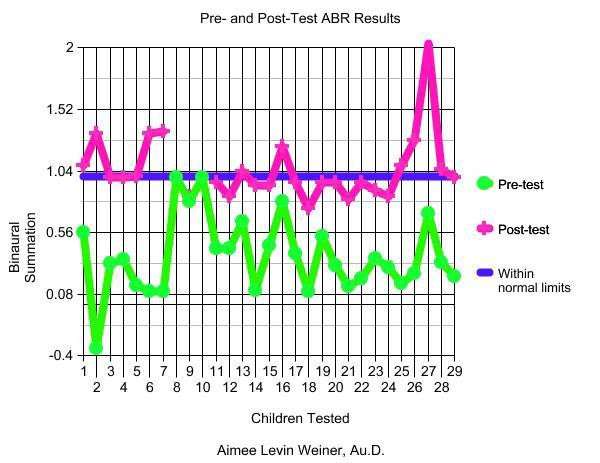INVESTIGATORS: JULIA HARPER, OTR/L, AIMEE LEVIN WEINER, AUD.
PUBLICATION: Advance OT (Occupational therapy) Magazine – January 4, 2010
ABSTRACT: 29 children diagnosed with auditory processing disorder (APD) underwent a combined therapy of sound and SI Occupational Therapy at the Therapeeds clinic in Florida. The sound component was the receptive and expressive programs of Integrated Listening System (iLs); the movement program was the H.O.P.E. sensory motor program developed by Julia Harper, OT, founder of Therapeeds. Pre- and post-assessments were collected by Aimee Weiner, Au.D.
Pre-testing indicated that 0 of the 29 children had intact vestibular processing skills measured by the PrN and functional skills. On post-testing, all 29 were within normal limits.
Pre-testing showed that 28 of the 29 demonstrated ocular-motor deficits in the areas of visual pursuits, saccades and convergence/divergence skills. Post intervention, 25 of the 29 demonstrated intact ocular motor skills.
Post-intervention, 22 of the 29 children had auditory processing skills that were completely within normal limits in every area.
Seven of 29 children began this therapy on medication for attentional concerns. By the end of the program, the medications for all 7 had all been discontinued.
Parents and teachers reported improvements in social skills, language, improved grades in reading and math, with most of the kids showing definite improvement in reading comprehension.
Auditory Brainstem Response (ABR – see graph on following page) is an electrophysiological test, similar to an EEG, which measures neural integrity through the brainstem. The ABR is an objective test which shows if the ears are coordinated well at the brainstem; when they are not, one might as well be listening with one ear. For students, this is a serious deficit, most often appearing in the areas of sound quality, localization ability and auditory figure ground discrimination.
Pre-intervention ABR tests showed all 29 children had little difference between listening with one ear and listening with both ears (binaural summation). Post-intervention, all 29 tested in the normal range.

Co-Author Dr. Weiner’s Comments:
“I have been looking at auditory processing disorders now for 28 years, and until recently, I have never seen auditory processing skills really get better. While there may be some improvement with age, the initial processing issues seem to persist. But over the last two years, while quantifying iLs and HOPE Method (sensori-motor program) results, I’ve watched children come in with auditory processing problems and leave without them.
In our data on the 29 children diagnosed with APD, all 29 went from below normal limits to at or above normal limits in the area of auditory decoding skills. These skills include listening to soft speech, listening to filtered speech (being far away from a speaker), auditory figure ground discrimination (listening in noise), and auditory sound blending (important skill for learning to read by phonics).
While all of the children showed some improvement in the other areas of auditory processing, 22 of the 29 tested at or above normal limits in ALL areas of auditory processing (auditory decoding, prosodics, integration, organization, and association) after the program.”
Original article in Advance OT Magazine: http://occupational- therapy.advanceweb.com/ebook/magazine.aspx?EBK=OT010410#/26/
